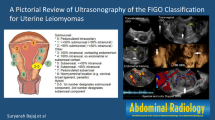Abstract
Aim
Utero vaginal prolapse is a very common complaint of patients in the OPD. It’s an entity that existed since a very long time and hence many classifications were proposed; however, only one system was found to be a validated system for determining the degree of prolapse—POP-Q system.
Objective
To determine the relationship of decubitus ulcer with POP-Q staging.
Materials and Methods
A prospective study of 100 patients with complaints of prolapse (something coming out of vagina) was considered. The patients were staged in accordance with POP-Q system. The number of patients with decubitus ulcer were noted. The area of each decubitus ulcer was also noted, by measuring the radius. Statistical tests were applied to find out if the relationship of the presence of and the area of decubitus ulcer with stage of prolapse was significant.
Results
It was found that as the stage of prolapse increased, the number of patients with decubitus ulcer also increased. Also, as the Point C measurement increased, the area (small/medium/large size) of the decubitus ulcer also increased.
Conclusion
There is a definite correlation between the presence of decubitus ulcer along with its area and the POP-Q component. The study also indicated that POP-Q staging is the only method of classification available that allows accurate and standardized measurements, foregoing pitfalls of all previous classifications.


Similar content being viewed by others
References
Kobashi KC. Evaluation of patients with urinary incontinence and pelvic prolapse. In: Wein AJ, editor. Campbell-Walsh textbook of Urology, 10th edn. Philadelphia: Elsevier-Saunders; 2012.
Swift S, Woodman P, O’boyle A, et al. Pelvic organ support study (POSST): the distribution, clinical definition, and epidemiologic condition of pelvic organ support defect. Am J Obstet Gynecol. 2005;192:795–806.
Swift S. Classification and epidemiology of pelvic organ prolapse. In: Cardozo L, Staskin D, editors. Textbook of female urology and urogynecology. 2nd ed. Oxon: Informa Healthcare; 2006. p. 999–1008.
Daftary S, Chakravarti S. Manual of obstetrics. 3rd ed. New York: Elsevier; 2011. p. 1–34.
Bump RC, Mattiasson A, Bo K, et al. The standardization of terminology of female pelvic organ prolapsed and pelvic floor dysfunction. Am J Obstet Gynecol. 1996;175(1):10–7.
Auwad W, Freeman RM, Swift S. Is the pelvic organ prolapsed quantification (PoPQ) being used? A survey of ICS and AUGS. Int Urogynecol J Pelvic Floor Dysfunct. 2004;15(5):324–7.
Reich A, Kohorst F, Krienberg R, et al. Influence of bladder volume on pelvic organ prolapsed quantification results. Gynecol Obstet Investig. 2010;70(2):82–6.
Treszezamsky AD, Rascoff L, Shahryarinejad A, et al. Use of pelvic organ prolapse staging systems in published articles of selected specialized journals. Int Urogynecol J. 2010;21(3):359–63.
Raizada N, Mittal P, Suri J, et al. Comparative study to evaluate the intersystem association and reliability between standard pelvic organ prolapse quantification system and simplified pelvic organ scoring system. J Obstet Gynaecol India. 2014;64(6):421–4.
Abdullah B, Khong SY, Tan PC. Oestrogen-soaked vaginal packing for decubitus ulcer in advanced pelvic organ prolapse: a case series. Int Urogynecol J. 2016;27(7):1057–62. https://doi.org/10.1007/s00192-015-2930-3 Epub 2015 Dec 30.
Bharathi HR, Vana H. An unusual case of myiasis in an elderly woman with uterovaginal prolapse. Indian J Obstet Gynecol. 2015;3(2):107–8.
Chaudhari SK. Operative treatment of genital prolapse in young women. J India Med Assoc. 1983;80:167.
Das RK. Surgical treatment of genital prolapse, a review of 200 consecutive cases. J Obstet Gynaecol India. 1968;18:116–25.
Sheth SS. Clinical evaluation of vaginal hysterectomy. J Obstet Gynaecol India. 1966;16:534–9.
Chandrakant MS, Hemant DG, Yogesh TI. POPQ examination: does the time of examination interfere with POPQ measurement system for analysis of the assessment of genital prolapse? J Evol Med Dent Sci. 2015;4(101):16694–7.
Deshpande HG, Madkar CS, Joshi UP. The relation of urinary problems in genital prolapse with POPQ component. Indian J Appl Sci. 2016;6(3):561.
Riss P, Dwayer PL. The POP-Q classification system: looking bad and looking forward. Int Urogynecol J. 2014;25:439–40.
Ovama A, Steinberg AC, Watai TK, et al. Pelvic organ prolapse quantification in literature. Female Pelvic Med Reconstr Surg. 2012;18(1):35–6.
Author information
Authors and Affiliations
Corresponding author
Ethics declarations
Conflict of interest
All authors declare that they have no conflict of interest.
Ethical Standards
All procedures followed were in accordance with the ethical standards of the responsible committee on human experiments and with the 1975 Declaration of Helsinki and revised in 2008(5).
Informed Consent
Informed consent was obtained from all the patients included in the study.
Additional information
Dr. Hemant G. Deshpande, MD, OBGY, is an HOD OBGY Department, at the Dr. D. Y. Patil Medical College and Research Centre, Pimpri, Pune, Maharashtra, India; Dr. Chandrakant S. Madkar, MD, DGO, OBGY, is an Professor OBGY Department, at the Dr. D. Y. Patil Medical College and Research Centre, Pimpri, Pune, Maharashtra, India; Dr. Saily R. Kiwalkar, is a Junior Resident, at the Dr. D. Y. Patil Medical College and Research Centre, Pimpri, Pune, Maharashtra, India.
Rights and permissions
About this article
Cite this article
Deshpande, H.G., Madkar, C.S. & Kiwalkar, S.R. Relationship of Decubitus Ulcer on Cervix in Pelvic Organ Prolapse with POP-Q Staging. J Obstet Gynecol India 69, 266–271 (2019). https://doi.org/10.1007/s13224-018-1127-3
Received:
Accepted:
Published:
Issue Date:
DOI: https://doi.org/10.1007/s13224-018-1127-3




